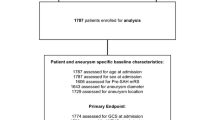Summary
Background. Most scales used to assess prognosis after subarachnoid haemorrhage (SAH) are based on the level of consciousness of the patient. Based on information from a logistic regression model, Ogilvy et al. developed a new grading scheme (Massachussetts General Hospital (MGH) Scale) which applied a simple scoring method to each prognostic factor considered relevant such as level of consciousness, age, quantity of blood in the first CT scan and size of the aneurysm. The purpose of this study is to introduce a modified version of the MGH scale, built up using factors applicable to every patient suffering SAH, and compare this new scale to the World Federation of Neurological Surgeons scale (WFNS), the Glasgow Coma Scale (GCS) scale for SAH and the MGH scale.
Method. A series of 442 patients consecutively admitted to Hospital 12 de Octubre between January 1990 and September 2001 with the diagnosis of spontaneous SAH were retrospectively reviewed. Outcome was assessed by means of the Glasgow Outcome Scale measured six months after hospital discharge. Differences between grades of the WFNS, the GCS scale for SAH, the MGH scale and the new scale were computed by χ2 statistics. ROC curves were plotted for the different scales and their areas compared.
Findings. Both WFNS and GCS scales fail to present significant differences between most of their grades, while the proposed scale shows a constant inter-grade significant difference in predicting outcome. The proposed scale presents a significantly higher prognostic efficacy in the whole series of patients suffering spontaneous SAH, patients with idiopathic subarachnoid haemorrhage (ISAH) and patients with confirmed aneurysmal SAH. The MGH scale is not applicable to some groups of patients suffering SAH.
Interpretation. Grading scales including additional factors to the level of consciousness show higher prognostic efficacy. The proposed modification of the MGH scale makes it applicable to every patient suffering SAH without losing its prediction capability.
Similar content being viewed by others
Author information
Authors and Affiliations
Rights and permissions
About this article
Cite this article
Lagares, A., Gómez, P., Alen, J. et al. A comparison of different grading scales for predicting outcome after subarachnoid haemorrhage. Acta Neurochir 147, 5–16 (2005). https://doi.org/10.1007/s00701-004-0417-y
Published:
Issue Date:
DOI: https://doi.org/10.1007/s00701-004-0417-y




